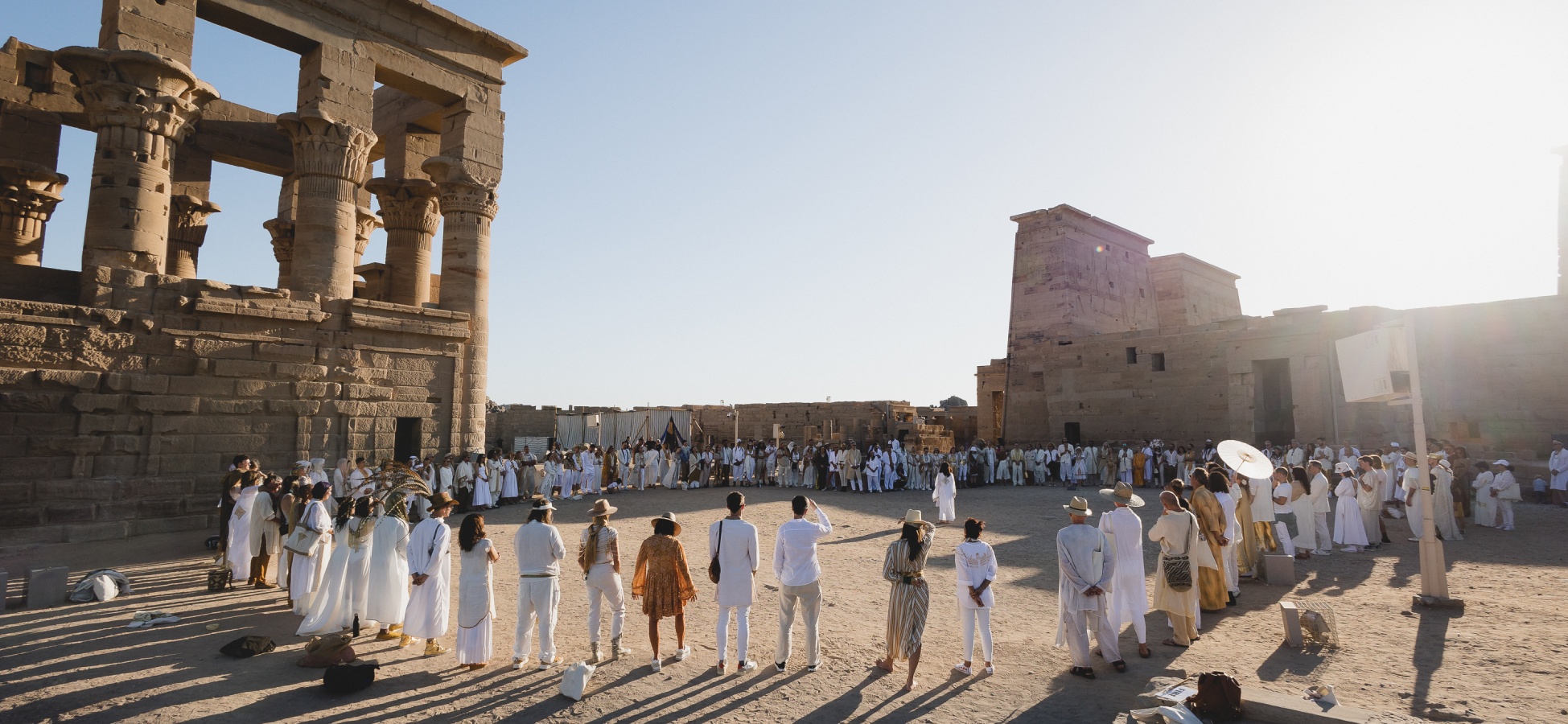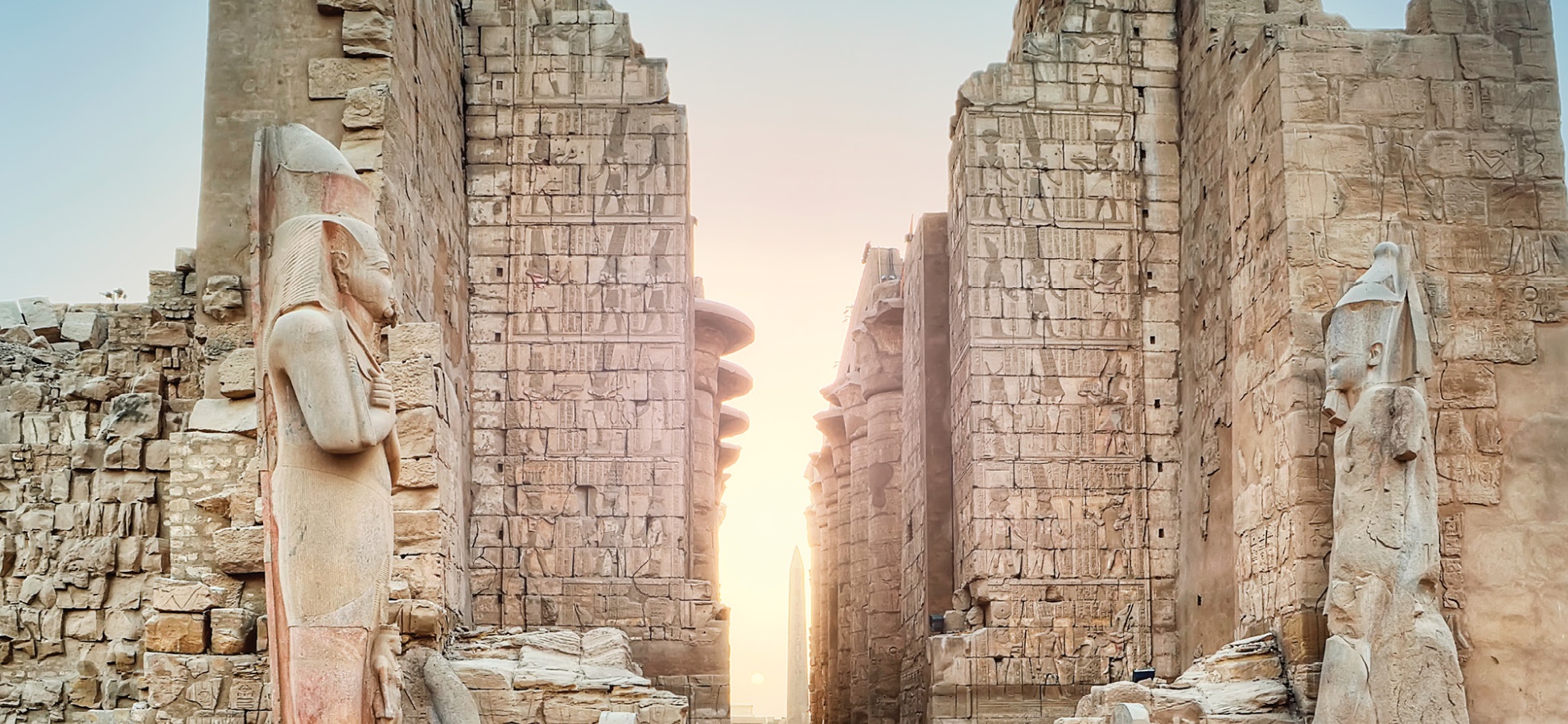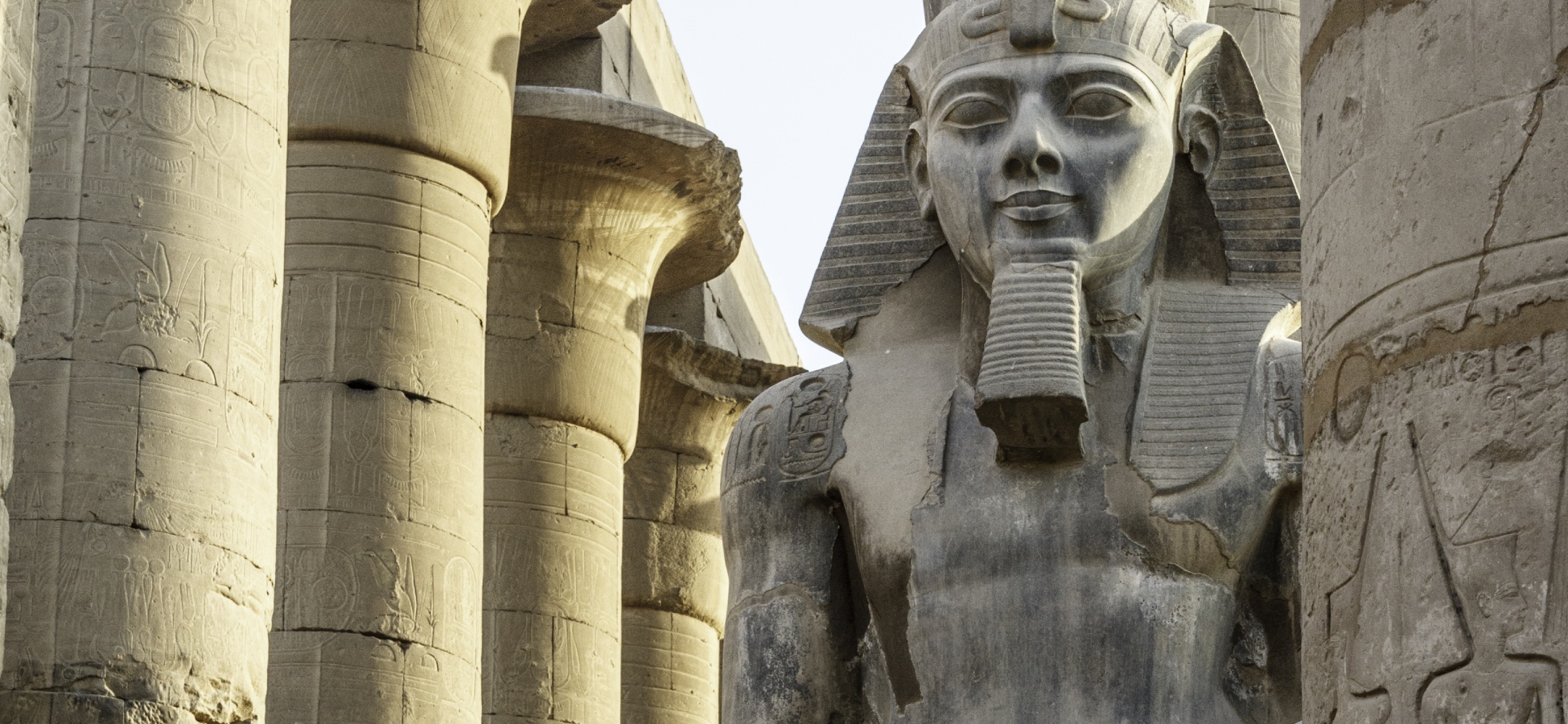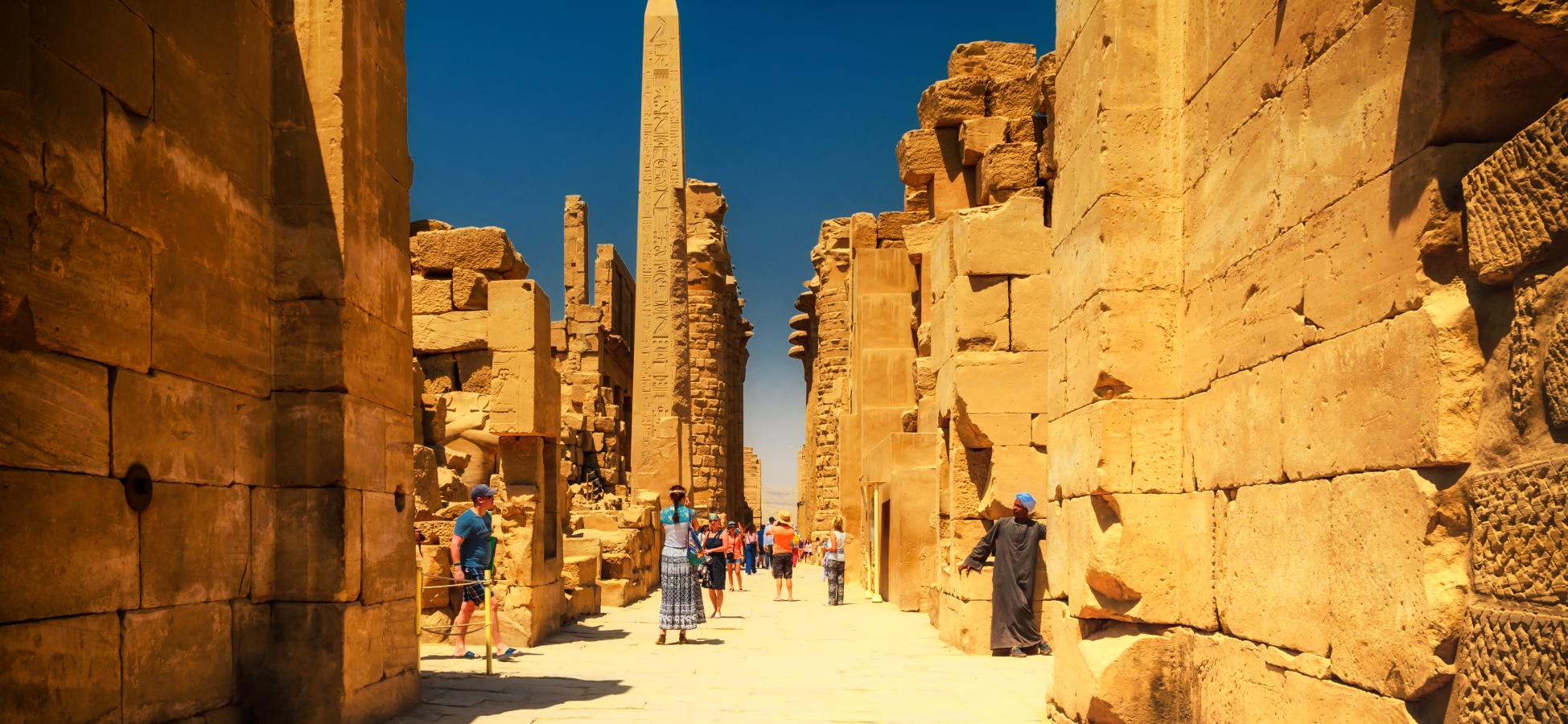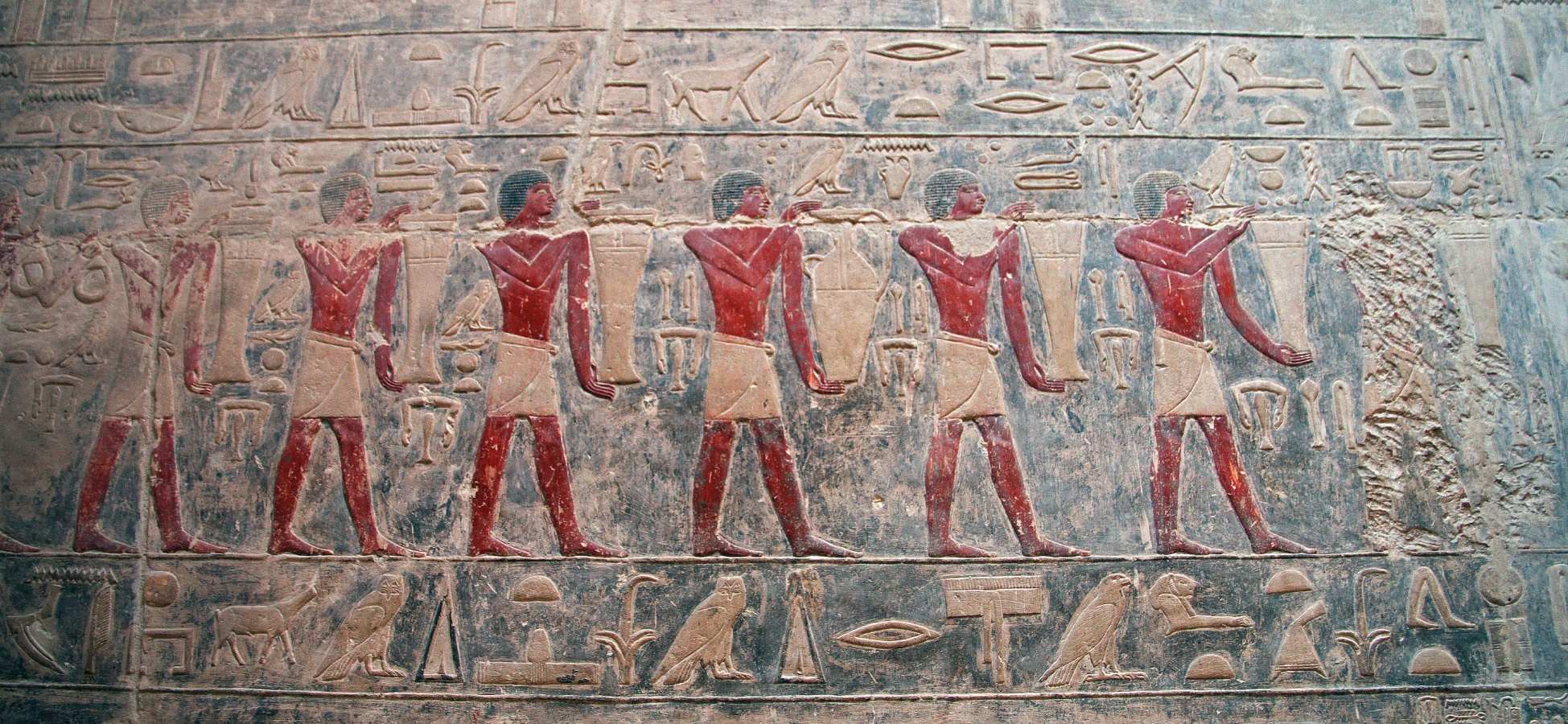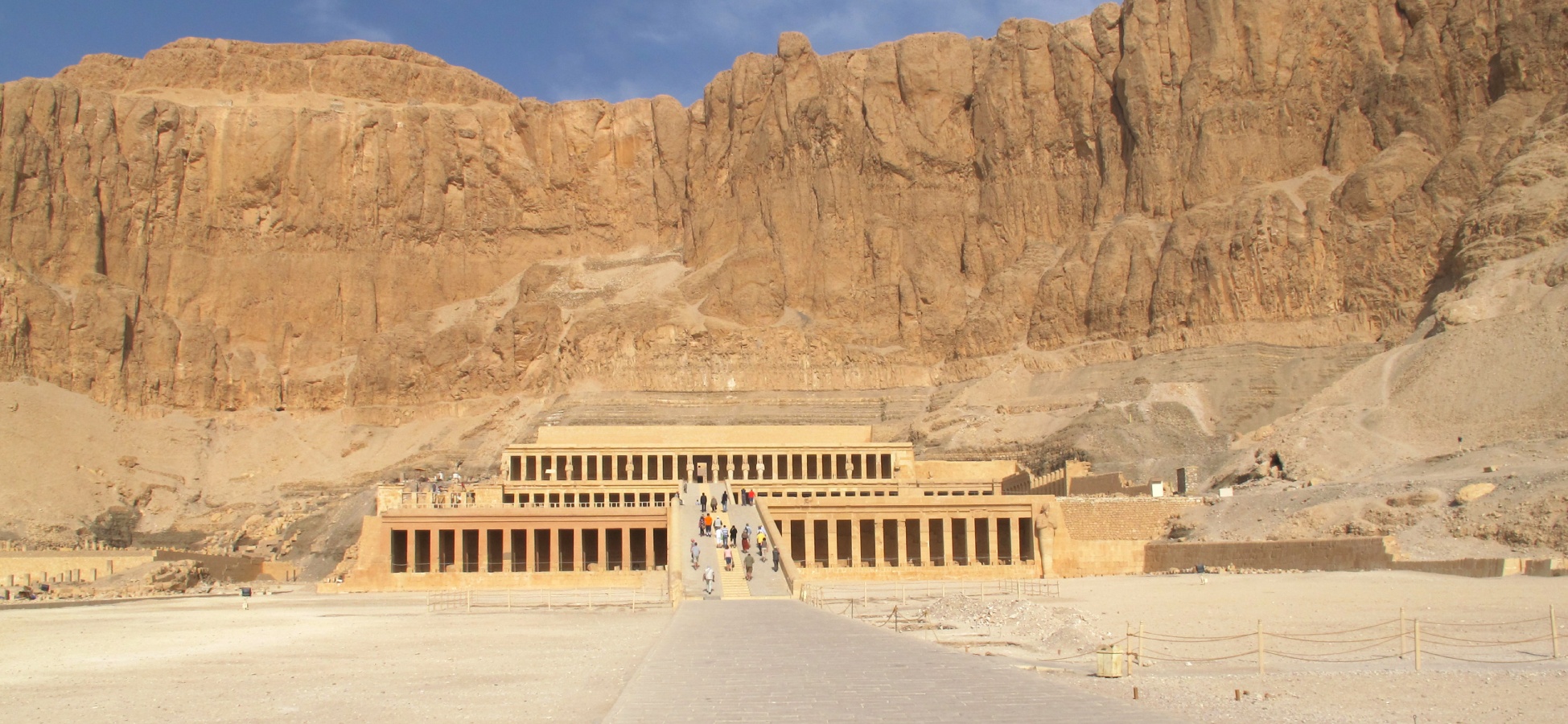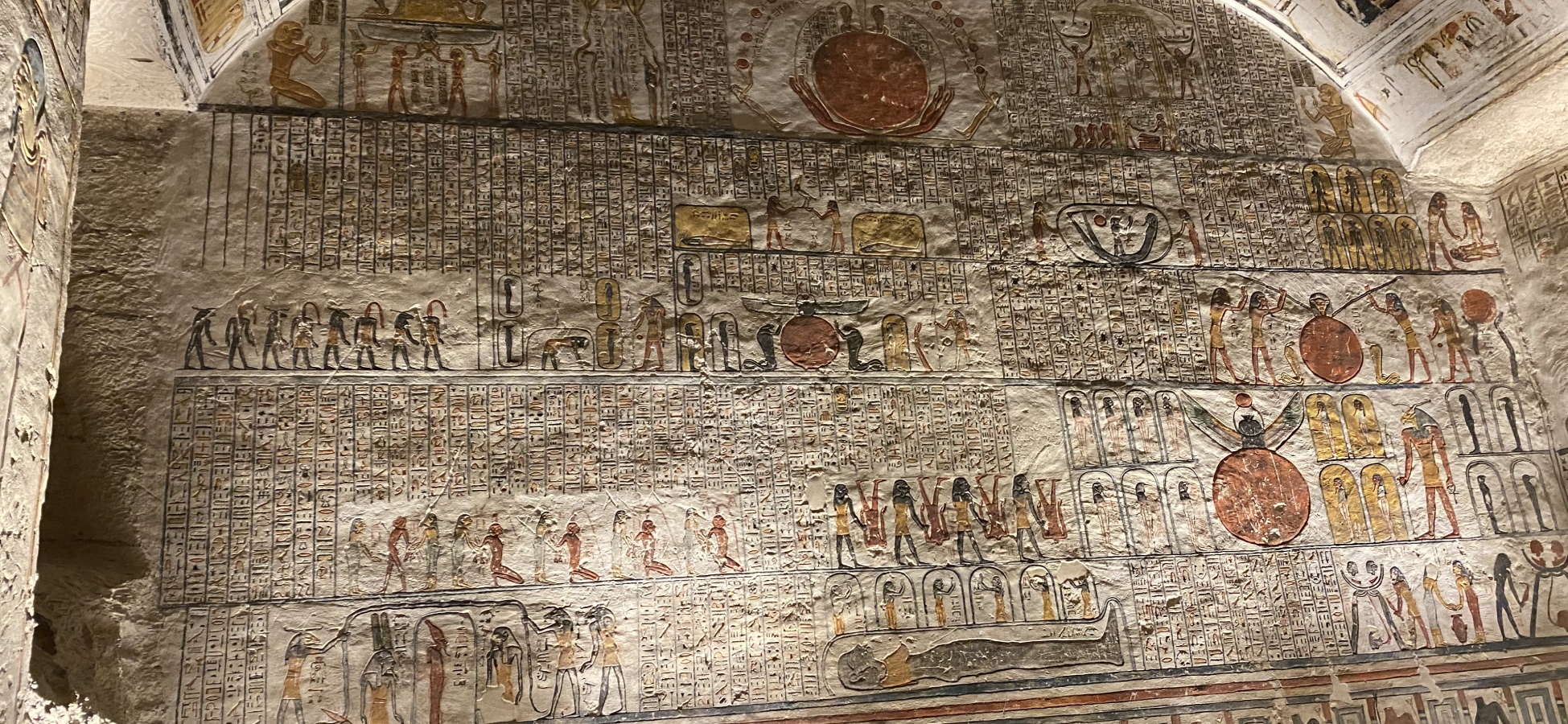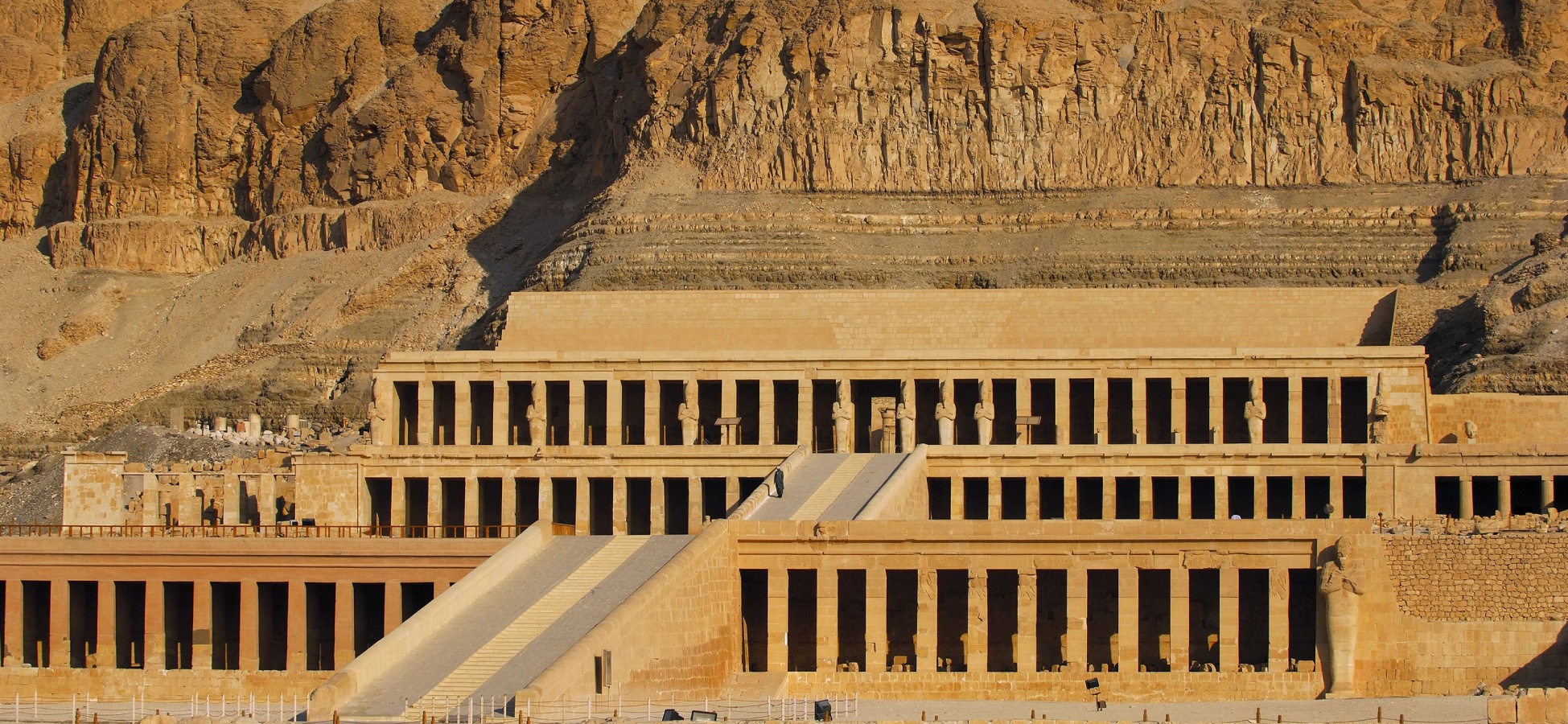
Karnak Temple
It is called Ipet-Sut “The Most Select of Places” by the ancient Egyptians, Karnak Temple was the most important temple in Thebes (modern Luxor), in Upper Egypt. This was where the cult of the great god Amun of Thebes was conducted. As such, it was extremely wealthy and its priesthood held great political power.
The temple is located on the east bank of Luxor. Like most ancient Egyptian temples, it is built on an east–west axis. Ancient Egyptian temples were models of the cosmos, and this layout meant that they mirrored the sun god’s trajectory through the sky. Rather uniquely, however, it also possesses a north–south axis, which orients it towards another temple, the abode of Amenemopet known today as Luxor Temple. This was a different version of Amun specific to south Luxor. The two temples were linked by a processional way lined with sphinxes. This was used in one of the most important celebrations of the ancient Egyptian calendar, the Opet Festival.

Luxor Temple
Luxor Temple, Ipet resyt “Southern Sanctuary” to the ancient Egyptians, was so called because of its location within ancient Thebes (modern Luxor). It is located around three kilometers to the south of Karnak Temple, to which it was once linked with a processional way bordered with sphinxes. The oldest evidence for this temple dates to the Eighteenth Dynasty (c.1550–1295 BC).
Ipet resyt, unlike most other ancient Egyptian temples, is not laid out on an east-west axis but is oriented towards Karnak. This is because Luxor Temple was the main venue for one the most important of ancient Egyptian religious celebrations, when the cult images of Amun, his wife Mut, and their son, the lunar god Khonsu, were taken from their temples in Karnak, and transported in a grand procession to Luxor Temple so they could visit the god that resides there, Amenemopet. This was the Opet Festival.

Deir Al-Bahari Temple
The celebrated temple of Hatshepsut (c.1473–1458 BC), the queen who became Pharaoh, is located here, in Deir al-Bahari, on the west bank of Luxor. Made up of three man-made terraces that gradually rise up toward the sheer cliff face, this structure is truly a sight to behold.
he temple of Hatshepsut served as a mortuary temple for the female pharaoh and her revered father, Thutmose I. Sunset was regarded as the daily death of the sun god before his glorious rebirth in the east. Given its funerary nature, Hatshepsut’s mortuary temple was built on the west bank of the Nile, directly across the river from the main temple of Amun in Karnak. The statues of this god, his wife Mut, and their son Khonsu left their temples every year during the Beautiful Feast of the Valley, and crossed the Nile to visit the royal mortuary temples, including Hatshepsut’s, which appears to have been one of their most important stops.

Colossi of Memnon
The Colossi of Memnon are two massive stone statues of the Pharaoh Amenhotep III, which stand at the front of the ruined Mortuary Temple of Amenhotep III, the largest temple in the Theban Necropolis. They have stood since 1350 BC, and were well known to ancient Greeks and Romans.
The twin statues depict Amenhotep III (fl. 14th century BC) in a seated position, his hands resting on his knees and his gaze facing eastwards (actually ESE in modern bearings) towards the river. Two shorter figures are carved into the front throne alongside his legs: these are his wife Tiye and mother Mutemwiya. The side panels depict the Nile god Hapi.

The Valley of the Kings
The rulers of the Eighteenth, Nineteenth, and Twentieth Dynasties of Egypt’s prosperous New Kingdom (c.1550–1069 BC) were buried in a desolate dry river valley across the river from the ancient city of Thebes (modern Luxor), hence its modern name of the Valley of the Kings. This moniker is not entirely accurate, however, since some members of the royal family aside from the king were buried here as well, as were a few non-royal, albeit very high-ranking, individuals. The Valley of the Kings is divided into the East and West Valleys. The eastern is by far the more iconic of the two, as the western valley contains only a handful of tombs. In all, the Valley of the Kings includes over sixty tombs and an additional twenty unfinished ones that are little more than pits.
The site for this royal burial ground was selected carefully. Its location on specifically the west side of the Nile is significant as well. Because the sun god set (died) in the western horizon in order to be reborn, rejuvenated, in the eastern horizon, the west thus came to have funerary associations. Ancient Egyptian cemeteries were generally situated on the west bank of the Nile for this reason.

The Valley of the Queens
Valley of the Queens, also called Valley of the Tombs of the Queens, Arabic Wādī al-Bībān al-Harīm, or Wādī al-Harīm, gorge in the hills along the western bank of the Nile River in Upper Egypt. It was part of ancient Thebes and served as the burial site of the queens and some royal children of the 19th and 20th dynasties (1292–1075 BC). The queens’ necropolis is located about 1.5 miles (2.4 km) west of the mortuary temple of Ramses III (1187–56 BC) at Madīnat Habu. There are more than 90 known tombs, usually consisting of an entrance passage, a few short halls, and a sarcophagus chamber. The earliest may be that of Sitre, wife of Ramses I. The most notable are those of Nefertari, the favourite queen of Ramses II; of Princes Khaemwese and Amonhirkhopsef; and of a Ramesside queen called Titi. In 1979 UNESCO added the Valley of the Queens to the World Heritage.

Medinet Habu Temple
Medinet Habu is the Arabic name for the mortuary temple of Ramses III. Located on the west bank of Luxor, this temple made of sandstone is the second largest complex in the area, the first being Karnak. It closely resembles the Ramesseum in structure and design.
The second pharaoh of the twentieth dynasty, Ramses III, is considered the last great pharaoh of Egypt and his mortuary temple is covered with reliefs of his conquests. His reign lasted from 1186 to 1155 BC. The memorial temple has 7,000 square meters of well-preserved decorated surfaces.

Abu Simbel Temple
Abu Simbel is an ancient temple complex, originally cut into a solid rock cliff, in southern Egypt and located at the second cataract of the Nile River. The two temples which comprise the site were created during the reign of Ramesses II (c. 1279 - c. 1213 BCE) either between 1264 - 1244 BCE or 1244-1224 BCE. The discrepancy in the dates is due to differing interpretations of the life of Ramesses II by modern day scholars. It is certain, based upon the extensive artwork throughout the interior of the Great Temple, that the structures were created, at least in part, to celebrate Ramesses' victory over the Hittites at the Battle of Kadesh in 1274 BCE. To some scholars, this indicates a probable date of 1264 BCE for the initial construction as the victory would have been fresh in the memory of the people. However, the decision to build the grand monument at that precise location, on the border with the conquered lands of Nubia, suggests to other scholars the later date of 1244 BCE in that it would have had to have been begun after the Nubian Campaigns Ramesses II undertook with his sons and was built as a symbol of Egypt's power.

Edfu Temple
Edfu Temple is one of the most striking and complete of ancient Egyptian temples and is dedicated to the worship of the god Horus. Situated on the western bank of the Nile, its construction began during the reign of Ptolemy III in 237 BC, but was completed in the reign of Ptolemy XII in 57 BC, 180 years later.
The temple is fronted by two massive pylons that bear scenes of Ptolemy XII conquering his enemies and worshipping deities. Two large granite statues of the falcon-god Horus stand before the pylons. Once through the pylons you enter into a large Peristyle court lined with columns decorated with floral capitals. Beyond this court are two Hypostyle Halls, the first illustrates the temple’s foundation with the king engaged in worship, the second holds scenes of Horus’ journey in a sacred bark accompanied by the goddess Hathor. From the second Hypostyle Hall is the Transverse Hall, then the Sanctuary of the temple.

Kom Ombo Temple
The Temple of Kom Ombo is an unusual double temple in the town of Kom Ombo in Aswan Governorate, Upper Egypt. It was constructed during the Ptolemaic dynasty, 180–47 BC. Some additions to it were later made during the Roman period.
The building is unique because its 'double' design meant that there were courts, halls, sanctuaries and rooms duplicated for two sets of gods. The southern half of the temple was dedicated to the crocodile god Sobek, god of fertility and creator of the world with Hathor and Khonsu. Meanwhile, the northern part of the temple was dedicated to the falcon god Haroeris ("Horus the Elder"), along "with Tasenetnofret (the Good Sister, a special form of Hathor or Tefnet / Tefnut) and Panebtawy (Lord of the Two Lands). The temple is atypical because everything is perfectly symmetrical along the main axis.

Philae Temple
The monuments of Philae include many structures dating predominantly to the Ptolemaic Period (332–30 BC). The most prominent of these is a temple begun by Ptolemy II Philadelphus (285–246 BC), which he dedicated to Isis, the mother of Horus, the god of kingship. A scene in mammisi, or birth room, where the birth of Horus was celebrated, depicts Isis suckling her son Horus in the marshes.
The temple of Isis was one of the last ancient Egyptian temples to remain active, as it continued to function until the reign of the Byzantine Emperor Justinian I (527–565 AD), who ordered the foreclosure of all pagan temples. It is here that a priest of Isis named Esmet-Akhom carved the very last dated hieroglyphic inscription, which dates to the late 4th century AD (394 AD). The temple was converted into a Christian church and many inscriptions were deliberately destroyed.

Esna Temple
It is located on the west bank of the Nile some 55 km south of Luxor. The town was formerly part of the modern Qena Governorate, but as of 9 December 2009, it was incorporated into the new Luxor Governorate.
The temple of Esna, dedicated to the god Khnum, his consorts Menhit and Nebtu, their son, Heka, and the goddess Neith was remarkable for the beauty of its site and the magnificence of its architecture. It was built of red sandstone, and its portico consisted of six rows of four columns each, with lotus-leaf capitals, all of which however differ from each other. The temple contains very late hieroglyphic inscription, dating from the reign of Decius (249–251 AD).

Dendera Temple
ng the main axis. Philae Temple The monuments of Philae include many structures dating predominantly to the Ptolemaic Period (332–30 BC). The most prominent of these is a temple begun by Ptolemy II Philadelphus (285–246 BC), which he dedicated to Isis, the mother of Horus, the god of kingship. A scene in mammisi, or birth room, where the birth of Horus was celebrated, depicts Isis suckling her son Horus in the marshes. The temple of Isis was one of the last ancient Egyptian temples to remain active, as it continued to function until the reign of the Byzantine Emperor Justinian I (527–565 AD), who ordered the foreclosure of all pagan temples. It is here that a priest of Isis named Esmet-Akhom carved the very last dated hieroglyphic inscription, which dates to the late 4th century AD (394 AD). The temple was converted into a Christian church and many inscriptions were deliberately destroyed. Esna Temple It is located on the west bank of the Nile some 55 km south of Luxor. The town was formerly part of the modern Qena Governorate, but as of 9 December 2009, it was incorporated into the new Luxor Governorate. The temple of Esna, dedicated to the god Khnum, his consorts Menhit and Nebtu, their son, Heka, and the goddess Neith was remarkable for the beauty of its site and the magnificence of its architecture. It was built of red sandstone, and its portico consisted of six rows of four columns each, with lotus-leaf capitals, all of which however differ from each other. The temple contains very late hieroglyphic inscription, dating from the reign of Decius (249–251 AD). Dendera Temple The temple of Dendera dates back to the Ptolemaic Period, although evidence points to older structures once existing on the sitedating as far back as king Pepy II, from the Old Kingdom. Among the temple’s most notable features are astronomical engravings on its ceiling.
One of the primary celebrations that took place at Dendera was for the Egyptian New Year. The night before the new year, a statue of Hathor was brought out on a shrine and placed on the roof of the temple to receive the sun’s first rays, which symbolically renewed and the rejuvenated the goddess.

The Unfinished Obelisk
It was built in a very unique manner as it depended on a Greek style of architecture that had four sides converging to a mini pyramidal shape at the top of the obelisk. It was built in the new kingdom during the 18th dynasty by Queen Hatshepsut, the Wife of King Thutmose II (1478-1458 B.C) to be placed in the Karnak temple and to complement the Lateran Obelisk, originally located in Karnak before being moved to Rome. It is located in its original location a red granite quarry in Aswan and if completes, it would have measured 42 m making it the tallest obelisk in history but the project was unfortunately abandoned due to the discovery of numerous cracks in the obelisk. It would also have been the heaviest obelisk weighing 1200 tons.

Abydos Temple
The Temple of Seti I, also known as the Great Temple of Abydos, is a major historical site located in Abydos. The temple was built in 13th century BC by Seti I. Incorporated at the rear of the temple is the Osireion, a largely subterranean complex built with large stone blocks. The temple is also notable for the Abydos graffiti, ancient Phoenician and Aramaic graffiti found on the temple walls.


